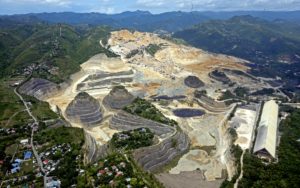NAGA CITY LANDSLIDE: Healing the land, the victims

NAGA AIREAL PHOTO IN GROUND ZERO/OCT.03,2018:Aireal photo of the landslide area in sitio Sindulan Barangay Tinaan Naga City were houses affected mark with to determine that they cannot come back photo taken from Airforce helicopter.(CDN PHOTO/LITO TECSON)
Displaced families from the landslide areas in Naga City will have to stay in evacuation centers until such time as the identification and establishment of a permanent resettlement area may take several months.
And as government now focuses its efforts to help the victims rebuild their lives, the 170-hectare critical zone within and around the so-called ground zero would need even more time to heal.
The Naga City government plans to reforest the area and establish an eco-park, as part of the rehabilitation of the landslide area and the surrounding danger zone.
“[Rehabilitating the critical area] is one of the needs nga i-identify nato for the Post Disaster Needs Assessment (PDNA) nga buhaton nato sa city government. Its a 170 hectare, more or less, no build zone nga kinahanglan nato i-develop into a green zone, a green buffer zone ba or an eco-park,” said Naga City Mayor Kristine Vanessa Chiong.
PDNA
Chiong said they will submit the PDNA for the landslide area and the families of the victims and other residents there.
“Amo sad na nga isubmit sa OCD [Office of Civil Defense] aron ma-budgetan pod nila (We will submit the PDNA to OCD so they can also allocate a corresponding budget for it.),” said Chiong.
The city government is still conducting a survey as to the number of houses within the 170-hectare critical zone and identify the families that will be displaced by the delineation of the unsafe zone.
As of yesterday, the team marked at least 370 houses.
The displaced families will be the beneficiaries of the socialized housing project that the National Housing Authority (NHA), which committed to build 320 housing units promised to complete the project within six to eight months from start of construction.
On the other hand, the city government, which committed to build 80 units, promised to finish the construction within three months.
Kitchens
Chiong said that they will also assess on how to assist the affected families during the construction of the housing units.
The Department of Social Welfare and Development (DSWD-7) will construct community kitchens in the evacuation centers and urged the public to donate cookware plates and utensils.
“We welcome food items, vegetables, fruits and spices. And they can also maybe donate meat and fish after we’ve already established the community kitchen,” Grace Yana, Social Welfare Officer of DSWD-7 said.
Chiong said they will look at options like rental or other evacuation centers where the affected residents can stay while awaiting for the housing units.
Transitional shelter
Yana said the evacuees cannot stay long at the evacuation centers, especially in schools.
“In one of our incident command meetings, the LGU has already planned in establishing transitional shelters,” Yana added.
She said the Naga City government and the provincial capitol are in the process of identifying a place for the transitional shelter and what type of transitional shelter will be built.
“We will look into the capacity of the City of Naga and Cebu Province in handling and transferring evacuees after the transitional shelter will be established,” she said, adding that DSWD-7 will continue to give technical input to make sure of an orderly transfer of evacuees.
Health
Meanwhile, Dr. Shelbay Blanco, Health and Emergency Management Staff (HEMS) coordinator of the Department of Health (DOH-7), said that records show that 548 evacuees have been diagnosed with acute respiratory infection, 235 with hypertension, 183 with diarrhea, 150 with fever and 290 with other symptoms.
In order to mitigate health problems in evacuation centers, Blanco said that they have already provided nutrition counseling for pregnant women, IEC materials for complementary feeding, nutrition assessment for infants, provision of vitamins, breast milk and among others.
Disclaimer: The comments uploaded on this site do not necessarily represent or reflect the views of management and owner of Cebudailynews. We reserve the right to exclude comments that we deem to be inconsistent with our editorial standards.
